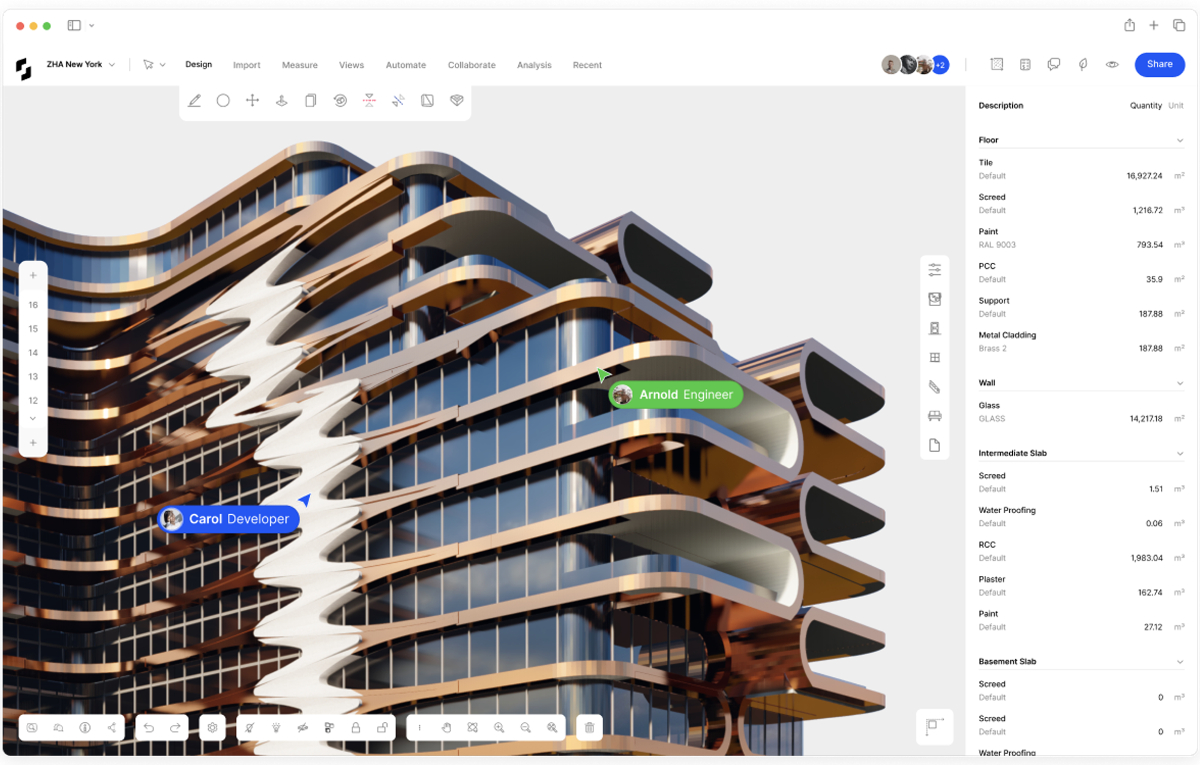Snaptrude — a startup aiming to compete against traditional platforms in the architecture, engineering and construction (AEC) design sector, including Autodesk, Trimble and Nemetschek — with its modern approach and cloud-based offering, has raised $14 million in a Series A round, just 10 months after announcing its seed funding.
With Foundamental and Accel leading the Series A round, the six-year-old startup has raised $21.8 million, including the $6.6 million seed round led by the same investors in January.
Snaptrude offers a modern, cloud-based software suite targeting architects, designers, developers and contractors to design and build their buildings in a collaborative and interoperable environment in real time. This is unlike legacy tools, such as Autodesk’s Revit and AutoCAD, where users do not get dedicated controls and features to collaborate with their colleagues or get interoperability, the startup said.
The platform works as an operating system for design and construction workflows, similar to how Figma functions for designers. Even though the problem is well-known and documented by various designers, architects and other stakeholders in the building information modeling (BIM) domain, Snaptrude is a rare New Age startup offering a full-fledged alternative to traditional solutions.
Be it a file coming from Revit, Rhino or SketchUp or from a simple PDF, Snaptrude can process design drafts from any of the largely used platforms. Likewise, designers can export their designs from Snaptrude to Revit, without any data loss, the startup said.
Founded in 2017, Snaptrude launched its platform out of beta earlier this year — after testing and getting feedback from thousands of users around the world. The startup is now looking to bring it to the next level.
“The product development velocity has been up to the point where we have started seeing dozens and dozens of firms globally who are working with us on a very close basis to be able to drive adoption. And that has really impacted the global visibility of what Snaptrude is about to do,” said Altaf Ganihar, founder and CEO of Snaptrude, in an interview.
The New York–headquartered startup has increased its user base from over 6,000 users to more than 20,000 since January, it said. These users are from over 30 countries, including the U.S., U.K. and India, among others.
Like other options in its segment, Snaptrude’s platform is available under a freemium model. A number of its initial users are very early enterprise customers who are expanding their accounts over time and moving from the free version to its paid option. Similarly, the startup has expanded its presence to a few dozen enterprise customers globally and counts Hines, WeWork and Square Yards in its customer base.
To get more customers and bring strong retention to the platform, Snaptrude has introduced a new version of its product, called Sketch to BIM. As its name suggests, the update enables users to create 3D BIM models from the initial sketch phase of a construction project, allowing for greater control over the design process and presenting an enhanced data stack on top. This will let users replace their existing design tools and consider Snaptrude the ultimate solution.
“We have actually proven with dozens and dozens of global firms that were able to replace it and work in their ecosystem — not just for test use cases but for their actual production use cases where they designed real buildings using the platform,” Ganihar said.
Snaptrude is also adding AI to help bring more efficiency. However, since designing and architecture involve copyrights, the startup is using existing base models, such as LLaMAs and GPTs, on top of the legacy knowledge of firms to offer them its AI integration alongside ensuring their data privacy.
The legacy knowledge, Ganihar explained, is what firms have used in their existing projects. The startup will utilize AI to resurface that knowledge through text-based prompts to provide access to the required information.
“That data is enough for firms to start making decisions . . . All of these are pretty standard, and you can start reusing them in your new designs,” he told TC.
The AI integration will help firms raise specific questions, such as the cost changes in the last few design iterations, or even broader prompts, like asking to draft a residential building in a particular city, and get quick results from the platform.
While market response for the latest updates is yet to be determined, Snaptrude has achieved investors’ interest twice in less than 12 months, when fundraising has become a challenge even for late-stage ventures. Ganihar said the reason the startup raised the fresh capital even after raising its reasonable seed amount during the slowdown was its predictable product.
“What has been a very easy point for us is we know what the journey looks like from here and the foundations we have demonstrated work. Now we just need to keep going deeper. We are not trailblazing at the moment,” he asserted.
“It’s a very capital-intensive business, and it takes a lot of time to create this IP. Even back in the day, Autodesk took eight to 10 years to get a version of a product that today dominates. We are in that phase where we could accelerate a lot of these efforts.”
With the new funding, Snaptrude looks to expand its current headcount of 53 people by growing its product and engineering teams. It also seeks to expand its go-to-market strategy and global reach.
“Snaptrude has emerged as the global front-runner in creating the next-generation design stack for the AEC industry. We’re delighted to be doubling down on our partnership with Altaf and Snaptrude and look forward to seeing how the platform grows to tackle this urgent challenge,” said Shubhankar Bhattacharya, general partner at Foundamental, in a prepared statement.
Currently, Snaptrude, which has its office in India’s Bengaluru, has the U.S. as its primary market, followed by the U.K. and Europe. It plans to focus more on these markets to expand its business.
“Snaptrude’s inventive conceptual design methodology, paired with its impressive market momentum, firmly establishes it as a pioneer in catalyzing transformation within the AEC sector. We wholeheartedly embrace their vision and are excited to remain steadfast in our support for their journey of expansion and innovation,” said Prashanth Prakash, partner at Accel.










